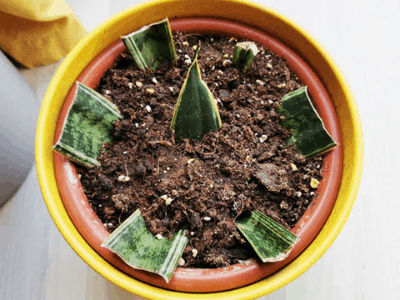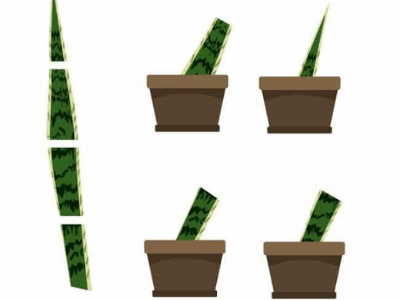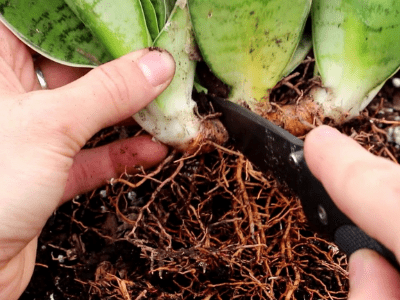How To Propagate Snake Plant 101
There’s nothing better than snake plants in your life or around your home.
Snake plants, other known as sansevieria, are gorgeous, easy to grow houseplants.
If you want this plant for your home and friends, you don’t have to purchase new plants right now.
Snake propagation is an easy method of growing new plants by taking cuttings.
Keep reading to learn how to grow this plant from cuttings.
Here we have story from John about his experience of propagating this plant and caring it for almost 4 years!
Let us hear John’s story
I remember the day when I first received my snake plant. It was about a year ago, and I had just moved…
...into this new house with my wife. We’ve been married for years now, but it only took one night to realize…
…that we were going to need some help with the plants in our backyard.
We drove around town until we found what looked like a yard sal…
…which was more of an outdoor garage sale if you want to get technical about it.
The lady at the stand said she would sell us any plant as long as we didn’t have any pets or kids…
…who might try and eat them! We bought a lot of plants.
Including my favorite plant, snake plant. I have an experience of having snake plant for almost 4 years…
….and I know how to propagate it well so I have no worries for duplicating my snake plant from 0.
And after 4 months, I have 32 snake plant from the result of propagating snake plant. Call me Dr. Snake Plant.

Learning how to propagate snake plants is easy. It’s true that too much water can kill your plant, but rooting a snake plant in water is one of the most foolproof methods.
Bonnie L. Grant, Certified Urban Agriculturist
What is the best way to grow snake plant cuttings? Snake plants are propagated in four basic ways:
- Snake plant propagation in water. If you cut off healthy leaves, you can regrow them in water.
- Snake plant propagation in soil. By directly inserting a leaf that you have removed directly into the soil, you can root cuttings.
- Propagation by division. Snake plants are easily divided in half.
- Propagation from rhizome. The right conditions can allow underground stems to form snake plants.
Are you ready to try propagating your own snake plants?
You’ll enjoy growing your own snake plant because it’s easy and enjoyable.
Read on to discover what can be done and how to choose the right method for you.

Here’s the main things that you should know!
Propagating Snake Plants In Water
Taking cuttings and rooting them in water is the easiest way to cultivate snake plants.
These leaves can be used for things like the leaves that fall over, bend, or break.
Occasionally, extra leaves are pruned away from your snake plant for its appearance.
The following items will be needed:
- Sharp knife or scissors
- Heavy glass, jar or vase
- Water
- Rooting hormone (optional)
You should carefully cut a leaf from near the soil, slicing it off with a blade or scissors.
When using root hormone, make sure to cut your cuttings cleaner and sharper.
If you like, you can also dip them in root hormone. In the next step, place the bottom portion of the leaf in water…
….ensuring that about 25% of the leaf is submerged in water.
The leaves of your snake plant can be sliced into sections and placed in water separately, as shown above.
Regardless of its orientation, it is important to keep the leaf in a similar position to when it was in the soil.
The snake plant’s leaves are highly polar, which means that roots will only grow if the edge…
…that touched the ground get submerged. You cannot grow new roots if you put the leaf in the wrong orientation.
My cuttings usually have a V shape cut in the bottom. This increases their success rate and serves several purposes.
Besides increasing the surface area of the cut edge in contact with the water…
it prevents the cut edge from pressing against the bottom of the glass or vase.
It also helps me identify the base of the leaf should I get confused.
As snake plant leaves are usually top heavy, you will need to place them in a jar or vase with a heavier bottom…
such as a mason jar or even a tall flower vase.
You should keep the leaf in a warm, indirect-light room, and change the water in the glass or vase once a week…
…or whenever the water seems cloudy. The process of seeing roots develop takes quite some time.
For roots to sprout from your cutting it will take approximately two months or longer.
There may also be some smaller shoots or growths originating from the roots.
After the roots have sprouted, plant your cutting in soil. Plant it as deep as the waterline of the leaf was.
Don’t worry about small shoots. They will grow as soon as they are ready.
Despite being the easiest method, it can take the longest if no indirect light is available to the plant.

Snake Plant Cuttings Propagated In A Soil Mix
The following items will be needed:
- Sharp knife or scissors
- Pot
- Any appropriate potting mixture or succulent soil
- Root hormone (optional)
Several cuttings can be made from a single leaf if the cuttings are rooted directly in the soil.
With a clean and sharp knife, cut off the leaf near the soil line and store it for future propagation.
Once the leaf is cut into multiple pieces that are about two inches in length each, using a very sharp knife,
divide it into multiple sections. The leaf pieces need to be left out for a few days for them to callus over…
…which will help the bacteria in the soil from entering the leaf and causing decay, as with all succulents.
You may wish to dip the snake plant cutting in rooting hormone powder so you will not lose track…
…of which part goes up and which part goes down. In a well-draining medium, like succulent soil…
…place a part of the plant that was close to the bottom or was under the sapling.
In about one month, plants will sprout roots and new growth.

Keep reading…
Propagation of Snake Plants by Division
The following items will be needed:
- Newspaper or outdoor space
- A clean, sharp knife or handsaw is best.
- Divide your plants into clean pots.
- A succulent potting mixture or soil
Propagation by division is a good option if you need more snake plants fast.
Simply lay the plant on its side and gently pull it out of its pot. You’ll need a newspaper or be outside if you do this.
Check the roots for the rhizomes and separate the plant by half if it is a small plant…
…then separate it into more pieces if it is a large plant.
Cut the plant into sections by using a handsaw or even sharp shears.
There should be at least three rhizomes and one healthy leaf per section.
If there are no roots, the plant isn’t ready for division and you should wait for it to grow more roots…
….and rhizomes before splitting it. Make sure there are some roots in each section as well.
Repot each snake plant into a new pot after you have split the original plant into two separate plants.
Water your plants well and then leave them alone until the soil dries out completely.

Rhizome Propagation of Snake plants
Snake plants have stems that grow underground and horizontally called rhizomes.
When these root systems grow young, they send off new shoots called pups.
If these pups are not large enough, the rhizomes can be used for the regrowth of new plants.
The following items will be needed:
- Outside space or newspaper
- Shears or knives with sharp edges
- For each rhizome, pots are now provided.
- A succulent soil blend or a potting mix
The snake plant should be flipped on its side and slid out of the pot. Look for rhizomes in the root area.
A rhizome is a white stalk that somewhat resembles a clove of garlic.
You should cut the rhizome off the plant using a clean, sharp knife. Don’t damage the roots around it.
Let the rhizome callus for a few days in the same way you would a soil cutting.
Once a callous has formed on the rhizome, you can transplant the seedling in a new pot.
Be sure to observe new growth as it emerges.
Best Conditions for Snake Plant Propagation
Some snake plant cuttings are not likely to survive propagation.
Even the best, most experienced growers suffer from losses of cuttings.
Optimal conditions for your cuttings will greatly increase your chances of success.
- Bright, indirect light.
- The right pot
- Clean pots and utensils.
- The right soil medium
- The right amount of water
Bright, Indirect Light
As established snake plants, they are very forgiving and can be grown in a wide variety of environments.
A few extra measures must be taken to ensure success when taking cuttings.
For faster growth, keep the cuttings in a room with bright indirect light.
This will encourage roots to grow in more quickly. Low lighting may cause the roots to take several months to grow.
The Right Pot
Because terracotta pots dry out the soil more thoroughly, they are great for snake plants and other succulents.
Because snake plants rot easily if over-watered, they work best with terracotta.
You need a pot with a drainage hole in the bottom for snake plants since tall snake plants can become top-heavy.
Also, a heavy pot works better as tall snake plants can become top-heavy.
Clean Pots And Utensils
The snake plant suffers from a wound when you cut it to propagate it. It can not only cause the plant to turn black…
…but also cause additional damage if it is not washed thoroughly prior to propagation.
Some growers will go as far as sterilizing the knives or shears before cutting plants.
Go on…
The Right Soil Medium
You won’t be able to overwater snake plants and other succulents.
This will cause them to get spongy under the leaves and rotten roots. Make sure your soil dries out between waterings.
The succulent soil can be purchased or made by adding extra perlite to regular potting soil.
Sea plants can be grown in soilless potting mixes, which is mainly a combination of perlite…
…and vermiculite with coarse sand and peat moss.
The Right Amount Of Water
If you are trying to care for succulents of any kind, especially snake plants, you are more likely to cause problems…
…if you overwater than if you underwater. These drought-tolerant plants thrive without water…
…so if you forget to water them, they’ll be fine. However, over-watering can cause a host of problems such as rotting…
…fungus, and damping-off of leaves and roots.
Wait until the top two to three inches of soil are completely dry before watering a plant.
When the top two to three inches of soil are completely dry water thoroughly so that the water runs out…
…the drainage hole and wait again until the top two to three inches of soil is completely dry.
The Right Temperatures
The snake plant grows extremely well in the house because it is tropical.
It prefers to be between 60 and 80°F (16 27°C). Snake plants may yellow and die or become brown…
…if temperatures dip below 50°F (10°C). They cannot withstand cold temperatures.
Last but not least…
What To Do When There is No Growth
Don’t fix a plant that doesn’t have visible growth. Just because you can’t see a plant growing, does not mean it is dead.
Your snake plant might look like it has completely stalled even after following all of the directions…
…which may make you wonder whether it is still alive.
Some snake plants or their cuttings may go dormant after a transplant, so if they are not dead, don’t throw them out.
Just keep them moist and provide optimal conditions for your cuttings.
Generally speaking, you can tell if your snake plant is dead by looking at the leaves if they have all turned yellow…
…if the root system is mushy, or if the plant has green leaves if you cut away the dying parts and repot the plant.
Other reasons for slow growth may include the fact that the plants are growing roots below the surface of the soil.
In some cases, snake plant cuttings need to grow a lot of roots before you start seeing growth surface.
You may want to check for root growth on stalled cuttings that have been placed in the ground for several months.
Or you may want to wait and see whether the plant is still alive.
There are two reasons why it takes so long to see growth at snake plants.
One reason is that many snake plants grow slowly compared to other plants.
The conditions of your plant, whether it is a potted plant or a plant in a container…
…can contribute to a decrease in the growth rate. Improper lighting and poor soil may make the plant dormant.
______________________________________________________________________________________________________________________________
Sum Up
See having Snake plant is good choice for you to have! It’s cool, its famous, it’s easy to have and care!
What else do you need? In this pandemic time like this, is a good choice for you to have an new activity…
…and having snake plant is a good choice for you to have!
Conclusion
Last thing for sure. This plant need to be care carefully, remember plant need the “love” too.
Alright that’s all for today! Do you have any questions about all of this?
Or do you want to add some method for propagating and care snake plant?
Let me know your recommendation from the comment below.
There are still many recent and interesting articles about Snake Plants..
..as well as other unique information from All Things Gardener..
For further information and other inquiries you can contact us here
I hope you can now take care your snake carefully and grow it big!
Thanks for reading this article! Bye!

